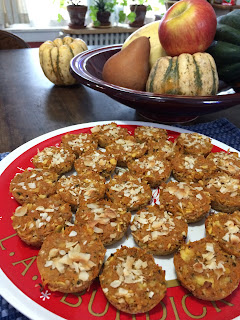Every December, my friendly next door neighbors host a Holiday Cookie Swap in their beautiful home. The whole street is invited and it's lovely, gathering together in such a warm, inviting setting. I always enjoy going. The only problem for me is cookies.
The way a Cookie Swap works is you arrive with two dozen cookies to share, and leave with your choice of two dozen assorted cookies, baked by others. In between is the party!
Mini Coconut Carrot Cakes are sugar-free and flour-free. The main ingredient is 1 pound of shredded organic carrots, bound together with 2 eggs. Also in the mix: a half cup each of shredded coconut and hulled hemp seeds, some spices, some lemon juice, and Lakanto monk fruit sweetener. So simple!
I wasn't sure how my little offerings would be received at the party, surrounded as they were on all sides by ginger snaps, chocolate chips, macaroons, creme brulée tarts and so on, but everyone loved them!
And you know what? As gorgeous as everyone's cookies looked, artfully displayed on gleaming counter tops and banquet tables, I enjoyed tasting them with eyes only.
Yes, I felt a little self conscious at first—not partaking, and all—but then I forgot about it, poured myself a glass of water and had a wonderful time catching up with neighbors. Even at a Cookie Swap, there's always more to life than food.
Mini Coconut Carrot Cakes
Makes 3 dozen
Ingredients
1 pound peeled organic carrots (roughly 4 large carrots)
1/2 cup shredded coconut, plus a little more to sprinkle on tops
1/2 cup hulled hemp seeds
2 large eggs (organic, pastured or free range)
2 teaspoons cinnamon
1/2 teaspoon nutmeg
3 Tablespoons Lakanto* monk fruit sweetener
2 pinches sea salt or Himalayan pink salt
1 Tablespoon lemon juice
Directions
Preheat oven to 350º F.
Shred the peeled carrots by hand, using the smaller size grating option on your stainless steel box or flat grater. Alternatively, use the food processor, which will yield a coarser shred. Sprinkle shredded carrots with lemon juice and set aside.
If you have a mixer, use it for the next step. If not, it's fine to proceed by hand using a large bowl, a whisk and a spoon. Either way, begin by beating the two eggs together. Then add cinnamon, nutmeg, Lakanto and salt, and beat some more. Add in shredded coconut and hemp seeds, and beat or stir to combine. Finally, add shredded carrots sprinkled with lemon juice. Mix in the carrots until batter is uniform.
Next, divide batter into 36 silicone mini muffin cups. I love these flexible little guys, even though they are made of weird stuff. I use them to make Chubby Checkers, too.
(If you don't have silicone mini muffin cups, Option 2 might be to use metal mini muffin tins lined with parchment paper, or to drop batter by the teaspoon onto a parchment lined cookie sheet. Better yet, get some silicone molds!)
When all the cups are full, sprinkle a little coconut on top of each to decorate. Place the silicone molds on a metal cookie sheet to avoid flopping, and place in oven.
Bake for 15-20 minutes, or until coconut on top begins to look toasted. Mine took exactly 20 minutes to perfection.
Remove tray from oven and allow to cool before removing mini cakes from molds. Store in the fridge, in a covered container. ♥︎
*I purchase my Lakanto directly from the manufacturer. If you'd like to do the same, here's their website www.lakanto.com This is the sweetener I use in my tea. It's made from a blend of non-fermenting monk fruit extract, and erythritoI (the only non-fermenting polyol). I prefer the Golden (looks like brown sugar), but the Classic (white) is good, too.


























